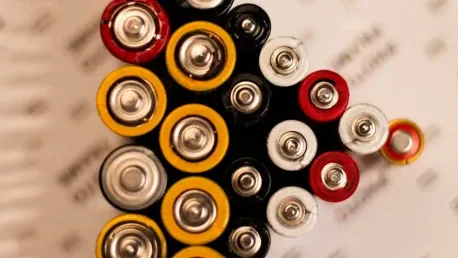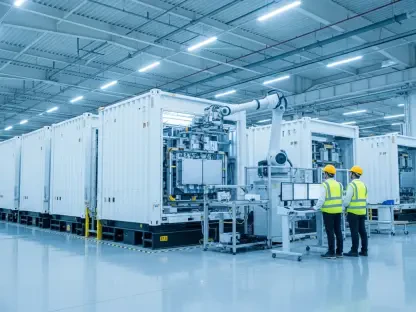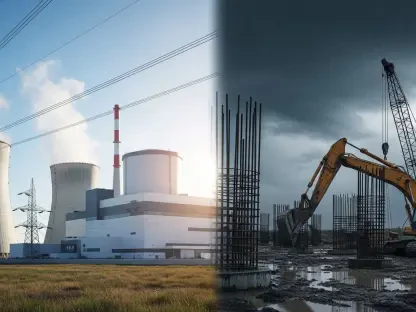The quest for sustainable energy solutions has led to significant advancements in battery technology. A recent groundbreaking collaboration between the Indian Institute of Technology (IIT) Madras and Hindustan Zinc Limited aims to develop a 1 kWh rechargeable zinc-air battery prototype, placing zinc-air batteries front and center in the discussion about next-generation energy storage. This initiative highlights zinc-air batteries as potential alternatives to the commonly used lithium-ion batteries, promising economical and environmental benefits.
Technological Innovation in Energy Storage
Advantages of Zinc-Air Batteries Over Lithium-Ion
Zinc-air batteries operate by combining zinc with oxygen from the air, resulting in high energy densities and longer durations of energy storage compared to lithium-ion batteries. One significant advantage is the extended lifespan, which can address the cycle life limitations faced by current lithium-ion technology. With a focus on durability, zinc-air batteries could become viable for applications requiring long-term reliability.
Additionally, the availability of zinc, a widely abundant material, contrasts sharply with the rare and geographically concentrated supply of lithium. This abundance contributes to more stable supply chains and potentially lowers the cost associated with raw materials. Zinc, unlike lithium, is not prone to the same market volatility, which means manufacturers and consumers could expect more predictable pricing and less disruption from geopolitical factors.
The scarcity of lithium and its uneven geographical distribution have raised concerns about sustainable sourcing and ethical mining practices. In contrast, zinc is more plentiful and distributed across a broader range of geographic locations, reducing the risk of monopolization and conflict. As a result, industries may find zinc-air batteries not only a technologically advanced option but also a more ethically sustainable choice.
Focus on Cost-Effectiveness
Economically, zinc is more than four times less expensive than lithium. This cost-efficiency translates into substantial savings when scaling battery production for commercial purposes. Reduced manufacturing costs can make energy storage solutions more accessible across various sectors, from residential solar power systems to large-scale grid storage. The reduced need for rare and expensive materials also makes it economically feasible to produce large quantities of these batteries without significantly inflating costs.
Moreover, the simpler construction of zinc-air batteries, which do not require the complex architectures needed for lithium-ion cells, further reduces production expenses. This simplicity can lower barriers to mass adoption and accelerate the widespread use of zinc-air technology. Manufacturers can benefit from simplified production lines, which contribute to reduced labor and operational costs, thereby enhancing overall profitability.
Simplicity in design also allows for easier scaling and adaptability to various applications, from small consumer electronics to large industrial needs. This flexibility can drive broader adoption of zinc-air batteries, providing a versatile solution that can meet diverse energy storage demands. Additionally, eliminating the need for extensive cooling systems, usually required for lithium-ion batteries, can further reduce operational costs and complexity.
Sustainability and Environmental Impact
Promoting Green Energy Solutions
Sustainability is a core focus of the collaboration between IIT Madras and Hindustan Zinc. Zinc-air batteries have the potential to reduce the environmental impact associated with battery production and disposal. Unlike lithium-ion batteries, which involve environmentally hazardous mining processes and difficult recycling procedures, zinc is more recyclable and less harmful to extract from the earth. This eco-friendly aspect makes zinc-air batteries a more sustainable option, fitting well with the global push towards greener technologies.
Moreover, the energy-intensive processes needed to produce lithium-ion batteries contribute to a significant carbon footprint. On the other hand, zinc-air batteries have a lower environmental cost throughout their lifecycle, from material sourcing to end-of-life disposal. The reduced energy demands in manufacturing and recycling processes make zinc-air batteries a much greener solution, adding to their overall appeal for environmentally conscious businesses and consumers alike.
The ease of recycling and the minimal environmental damage from extraction position zinc-air batteries as a viable alternative for companies looking to reduce their ecological footprints. As global regulations become increasingly stringent, the ability to produce and recycle batteries with minimal environmental impact will become a critical factor for compliance and sustainability. Zinc-air batteries offer a promising solution that aligns well with these regulatory trends, potentially providing companies with both a strategic and competitive advantage.
Aligning with Global Environmental Goals
The development of zinc-air battery technology aligns with broader global objectives to mitigate climate change and promote renewable energy usage. As countries worldwide strive to meet carbon reduction targets, the adoption of more sustainable energy storage solutions becomes imperative. Zinc-air batteries, with their eco-friendly attributes, can support these global efforts to shift towards greener energy.
Adopting zinc-air batteries can also facilitate the integration of renewable energy sources into power grids. Their ability to store large amounts of energy for extended periods helps address the intermittency issues inherent in renewable sources like solar and wind power. This capability to efficiently store and dispatch energy contributes to a more reliable and resilient power grid, aiding in the smooth transition to renewable energy.
Furthermore, the global push towards renewable energy sources necessitates the development of robust, sustainable energy storage systems. Zinc-air batteries offer the durability and efficiency needed to meet these requirements, helping to accelerate the adoption of renewable energy technologies. As countries and companies work towards meeting their carbon reduction goals, zinc-air batteries provide a viable and sustainable path forward.
Enhancing Industry-Academia Collaboration
Leverage of Academic and Industrial Expertise
The Memorandum of Understanding (MoU) between IIT Madras and Hindustan Zinc exemplifies the power of industry-academia partnerships. IIT Madras brings deep expertise in battery research and innovation, critical for pushing the boundaries of existing technology. Hindustan Zinc, as a leading player in the zinc industry, provides essential industry insights and resources necessary for prototype development and commercialization. This synergy is crucial for fostering innovation and accelerating the timeline from research to market-ready products.
This collaboration highlights the complementarity between academic insights and industrial capabilities. It sets a precedent for future partnerships aimed at accelerating technological advancements and bringing innovative solutions to market more efficiently. Combining the theoretical knowledge and innovative spirit of academia with the practical experience and resource availability of industry can lead to groundbreaking developments in energy storage technology.
Collaborations of this nature also serve as a model for how entities can leverage their unique strengths to overcome complex technological challenges. By pooling resources and expertise, IIT Madras and Hindustan Zinc can tackle the hurdles in zinc-air battery development more effectively. This integrated approach not only facilitates innovation but also strengthens the relationship between academia and industry, fostering a culture of continuous improvement and collaboration.
Driving Rapid Technological Advancements
Synergistic efforts between academic researchers and industry practitioners can drive rapid developments in zinc-air battery technology. By combining theoretical research with practical applications, the collaboration aims to overcome technical challenges and improve the performance and reliability of zinc-air batteries. This approach ensures that innovations move swiftly from the lab to the marketplace, benefiting both industries and consumers.
Furthermore, industry-academia collaborations can attract funding and investments necessary for large-scale development projects. By fostering a collaborative environment, such partnerships create a pathway for sustained innovation and growth in the energy storage sector. The influx of investments driven by these collaborative efforts can propel research to new heights, enabling quicker advancements and more comprehensive solutions.
These collaborations also offer educational benefits, providing students and researchers with real-world problems to solve and opportunities for hands-on learning. This real-world experience is invaluable for the development of practical skills and can drive further innovation as new minds enter the field. The combination of academic research, industrial know-how, and student involvement creates a dynamic environment capable of achieving significant technological breakthroughs.
Economic and Strategic Implications
Impact on Global Energy Market
The economic viability of zinc-air batteries can significantly impact the global energy market. Their cost-effectiveness can disrupt the current dominance of lithium-ion batteries, leading to a more diversified and competitive energy storage landscape. As zinc-air technology scales, it may offer competitive alternatives that drive down prices and spur new market opportunities. The introduction of cost-effective and efficient zinc-air batteries could open new markets and applications previously dominated by more expensive technologies.
The strategic advantages also extend to energy security. By reducing dependency on lithium, countries can enhance their energy resilience and reduce vulnerability to supply chain disruptions. This shift could lead to more stable and sustainable energy markets globally. The widespread adoption of zinc-air battery technology can mitigate the risks associated with geopolitical tensions and supply chain vulnerabilities, contributing to a more secure and resilient global energy infrastructure.
Moreover, the economic benefits of zinc-air batteries can have far-reaching implications for various industries. Reduced energy storage costs can lead to lower operational expenses for businesses and more affordable energy solutions for consumers. The ability to store and deploy energy more efficiently can drive down energy costs, making renewable energy sources more attractive and economically viable. This, in turn, can accelerate the transition to renewable energy, fostering a more sustainable and economically stable energy market.
Encouraging Policy and Regulatory Support
The drive for sustainable energy solutions has spurred major progress in battery technology. A recent groundbreaking collaboration between the Indian Institute of Technology (IIT) Madras and Hindustan Zinc Limited aims to develop a 1 kWh rechargeable zinc-air battery prototype. This effort places zinc-air batteries prominently in the conversation about next-generation energy storage solutions. The initiative underlines zinc-air batteries as viable alternatives to the more widespread lithium-ion batteries, offering both economic and environmental advantages.
Zinc-air batteries operate by using zinc and oxygen from the air to generate electricity, presenting a safer and potentially more cost-effective solution. Unlike lithium-ion batteries, which rely on scarce and expensive materials, zinc is abundant and cheaper. This makes zinc-air technology not only a financially viable alternative, but also one with a smaller environmental footprint. If successful, this collaboration could pave the way for more sustainable energy storage options and accelerate the transition away from fossil fuels, contributing significantly to global renewable energy goals.









